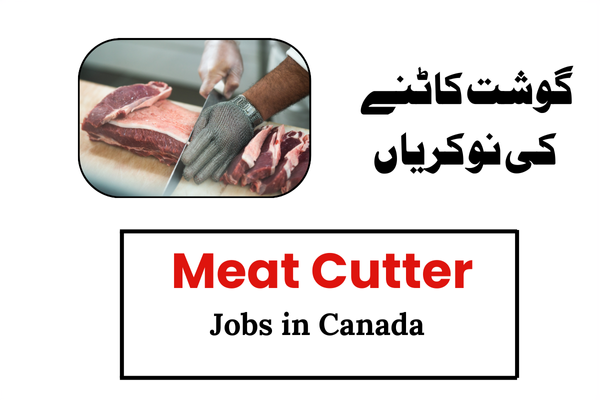The demand for skilled workers in Canada’s food industry is growing, and meat cutter jobs are at the forefront of this trend. These positions offer stable employment, competitive wages, and the chance to work in a vital sector of the economy. Whether you’re an experienced professional or a newcomer seeking entry-level opportunities, this guide will help you understand the scope, requirements, and benefits of meat cutter jobs in Canada.
What is a Meat Cutter?
A meat cutter, also known as a butcher, is responsible for preparing meat for retail or industrial purposes. This includes tasks such as deboning, trimming, slicing, and packaging meat products. Meat cutters work in various settings, including supermarkets, specialty butcher shops, meat processing plants, and wholesale facilities.
Why Consider Meat Cutter Jobs in Canada?
Canada’s diverse food industry relies heavily on skilled meat cutters. The country’s growing population and high demand for meat products ensure steady opportunities in this field. Here are some reasons to consider meat cutter jobs in Canada:
- Job Stability: The food industry is essential, providing consistent demand for meat cutting services.
- Competitive Wages: Meat cutter salaries range from CAD 18 to CAD 35 per hour, depending on experience and location.
- Career Advancement: Opportunities for promotion exist, from entry-level positions to supervisory roles.
- Immigration Opportunities: Meat cutting is often included in Canada’s list of in-demand jobs, making it a potential pathway for immigration.
Types of Meat Cutter Jobs in Canada
- Retail Meat Cutters Retail meat cutters typically work in grocery stores or specialty butcher shops. Their responsibilities include preparing meat for display, assisting customers, and maintaining cleanliness standards.
- Industrial Meat Cutters Industrial meat cutters work in processing plants, handling large quantities of meat. This role involves operating machinery, deboning, and preparing products for wholesale or export.
Qualifications and Skills Required
To succeed as a meat cutter in Canada, specific skills and qualifications are essential:
- Experience: While some positions provide on-the-job training, previous experience in meat cutting is often preferred.
- Education: Formal education is not mandatory, but a certification or diploma in meat processing can be advantageous.
- Physical Fitness: Meat cutting involves manual labor, requiring physical strength and stamina.
- Attention to Detail: Precision in cutting and trimming ensures product quality.
- Knowledge of Hygiene Standards: Adhering to food safety regulations is crucial in this role.
Wages and Benefits
The earnings of meat cutters in Canada vary depending on experience, location, and employer. Here’s a breakdown:
- Entry-Level Positions: CAD 18 to CAD 22 per hour
- Experienced Professionals: CAD 25 to CAD 35 per hour
- Overtime Opportunities: Additional pay for extra hours worked
Many employers also offer benefits such as health insurance, retirement plans, and paid time off.
Top Locations for Meat Cutter Jobs in Canada
Certain regions in Canada have a higher demand for meat cutters due to their agricultural and industrial hubs. Here are some provinces and cities to consider:
- Alberta: Cities like Calgary and Edmonton are home to large meat processing plants and retail outlets.
- Ontario: Toronto and surrounding areas offer numerous retail and industrial opportunities.
- British Columbia: Cities like Vancouver and Squamish have growing markets for retail butchers.
- Manitoba and Saskatchewan: These provinces are central to Canada’s agricultural sector, offering various meat processing roles.
How to Apply for Meat Cutter Jobs in Canada
Finding the right job as a meat cutter requires research and preparation. Here’s a step-by-step guide:
- Prepare Your Resume: Highlight relevant experience, skills, and certifications. Tailor your resume to match the job description.
- Search Online Job Portals: Websites like Job Bank Canada, Indeed, and LinkedIn are excellent resources for finding meat cutter positions.
- Network: Connect with industry professionals and join local job fairs to learn about openings.
- Apply Directly: Many companies accept direct applications through their websites or in person.
- Follow Up: After applying, follow up with the employer to express your interest.
Immigration Pathways for Meat Cutters
For skilled workers outside Canada, meat cutter jobs can serve as a pathway to immigration. Programs such as the Provincial Nominee Program (PNP) and the Temporary Foreign Worker Program (TFWP) frequently list meat cutting as an in-demand occupation. Check the specific requirements for each program to determine eligibility.
Tips for Success in Meat Cutting Careers
- Invest in Training: Enroll in a meat cutting course to improve your skills and employability.
- Prioritize Safety: Always follow workplace safety protocols to prevent accidents.
- Maintain Tools: Keep knives and equipment in good condition for efficient work.
- Stay Updated: Stay informed about industry trends and advancements in meat processing technology.
- Build Relationships: Strong relationships with colleagues and clients can lead to better opportunities.
Meat cutter jobs in Canada offer rewarding career opportunities for skilled individuals. With the right preparation, dedication, and training, you can build a stable and prosperous career in this essential industry. Whether you’re a local resident or an aspiring immigrant, the meat cutting profession is worth considering for its financial benefits, job security, and potential for growth.
Start your journey today by exploring the many job openings across Canada and take the first step toward a fulfilling career as a meat cutter.
Apply Now:
To apply send your CV to: recruitment@seafoodcity.com




